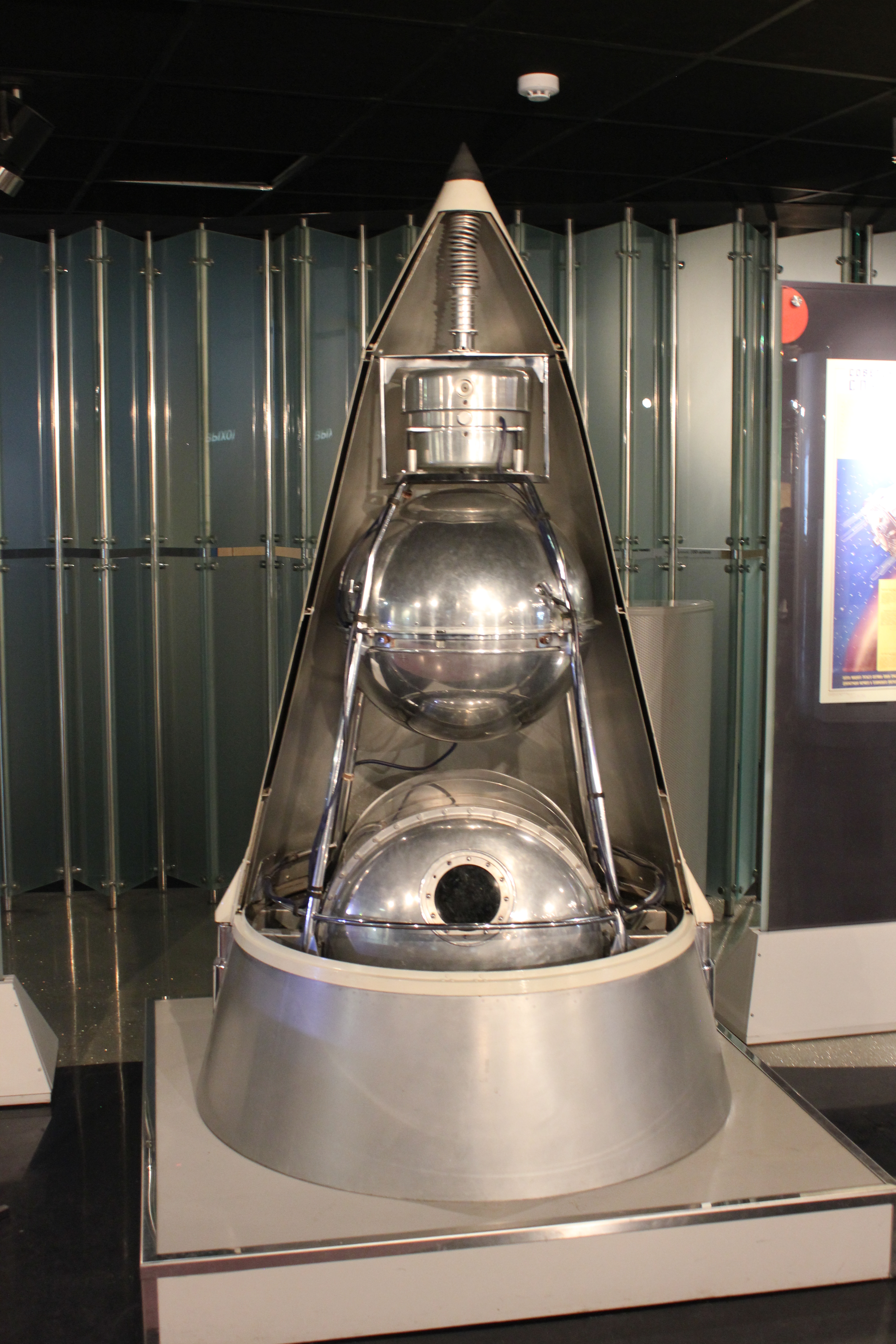In the years immediately following World War II, a period of geopolitical tension emerged between the U.S and the Soviet Union, known as the Cold War. Both of these postwar superpowers engaged in a game of technological one-upmanship. It was feared that if the Soviet Union developed the technology needed to go into space before the U.S., it would create a significant national security problem. Therefore, the “Space Race” was, in fact, a Cold War competition to see which of the two countries would be the first to achieve space flight.
This contest began with an announcement on July 29, 1955, when President Eisenhower’s press secretary, James C. Hagerty, announced that the United States planned to launch “small Earth circling satellites” between July 1, 1957 and December 31, 1958. This ambitious effort began the U.S. contribution to the International Geophysical Year. Four days later, on August 2, 1955, the Soviets responded by saying that they would put a satellite into orbit “in the near future.”
Indeed, on October 4, 1957, The U.S.S.R launched “Sputnik,” which means “traveler” in Russian. Sitting on top of a Soviet R-7 intercontinental ballistic missile, it became the first man-made object to orbit the Earth. The satellite weighed 183 pounds and was 22.835 inches in diameter and circled the Earth in an hour and 38 minutes.
Sputnik surprised and shocked many Americans. Space was viewed as the new frontier and the Soviet achievement was an affront to the American tradition of exploration. There was also grave concern that this powerful R-7 missile would be capable of carrying a nuclear warhead anywhere in the United States.
On November 3, 1957, The Soviets launched Sputnik 2, which was a cone-shaped capsule. This was the first spacecraft to carry a living animal, a dog named Laika. Sadly, the dog died from overheating on the fourth orbit, due to a malfunction in the craft’s air-conditioning system.

On January 31, 1958 the U.S. Army Ballistic Missile Agency launched America’s first artificial satellite, Explorer I. Utilizing a Jupiter C rocket developed under the guidance of Dr. Wernher von Braun, who worked on the V-2 missile program in Germany during World War II. The mission of the satellite was to measure cosmic radiation surrounding the Earth. The satellite was 80 inches long, 6.25 inches in diameter, weighed 30.66 pounds, and revolved around the Earth every 114.8 minutes.
On July 29, 1958, President Eisenhower signed the National Aeronautics and Space act of 1958, which created the National Aeronautics and Space Administration (NASA). Prior to this legislation, the responsibility for space exploration was relegated to the military, mirroring the Soviet model. The establishment of NASA came about as a result of a perceived inability of the U.S. military to keep up in the space race.
Eisenhower created two national space programs that would operate concurrently with NASA’s program. The U.S. Air Force was in charge of the first program, which was tasked with making the most of the military potential of space. The second, headed by the Central Intelligence Agency (CIA), the Air Force, and a newly-formed covert agency called the National Reconnaissance Office, code-named Corona, would utilize orbiting satellites to spy on the Soviet Union and its allies.
The Soviet space program continued to outpace its American counterpart. The Soviets launched Luna 2 on September 12, 1959, which crashed into the Moon. This was the first human-made object to reach the surface of another celestial body. Soviet cosmonaut Yuri Gagarin became the first person to go into space on April 12, 1961, in a capsule-like spacecraft named Vostok 1. Gagarin circled the Earth completing slightly more than one orbit in 108 minutes.
Nasa’s program, called Project Mercury, centered around a smaller cone-shaped capsule designed by NASA engineers. They tested the spacecraft with chimpanzees and conducted a final test flight in March of 1961. Astronaut Alan Shepard’s Mercury capsule was launched on May 5, 1961. Shepard became the first American in space, however, he did not achieve orbit.
From 1961 to 1964, NASA’s budget was increased a staggering 500 percent, and the lunar landing program included 34,000 NASA employees and university contractors who employed 375,000 people.
A little-known fact is the scientific role women played in NASA’s early space program. Computer technology was still in its infancy in the late 1950s and early 1960s, therefore humans made most of the calculations needed for launch, trajectory, and re-entry. The majority of these brilliant individuals, dubbed “computers,” were women.
There was a cadre of black female mathematicians working at Langley Research Center in Hampton, Virginia. The most notable of these was an extremely gifted mathematician named Katherine Johnson, who, in 1961, calculated and plotted the trajectory for Alan Shepard’s space capsule. Others in the group, such as Mary Jackson and Dorothy Vaughn, went on to become engineers and programmers. The movie, “Hidden Figures,” based on Margot Lee Shetterly’s 2016 book of the same name, details the monumental challenges these women faced due to racism and sexism.
On May 25, 1961, before a special joint session of Congress, President John F. Kennedy announced that he was setting the lofty goal of sending an American safely to the Moon before the end of the decade.
Kennedy was under enormous pressure to have the United States “catch up to and overtake” the Soviet Union in the “space race.” NASA’s human spaceflight efforts were guided by Kennedy’s speech. The later stages of Project Mercury and the subsequent Gemini and Apollo programs were designed to carry out Kennedy’s goal.

On July 16, 1969, the crew of Apollo 11, Neil Armstrong, Edwin “Buzz” Aldrin, and Michael Collins were launched into space, headed for the Moon. After landing successfully on July 20, Armstrong became the first man to walk on the moon’s surface, where he spoke those iconic words, “One small step for man, one giant leap for mankind.” By landing humans on the moon first, the U.S. “won” the space race.










